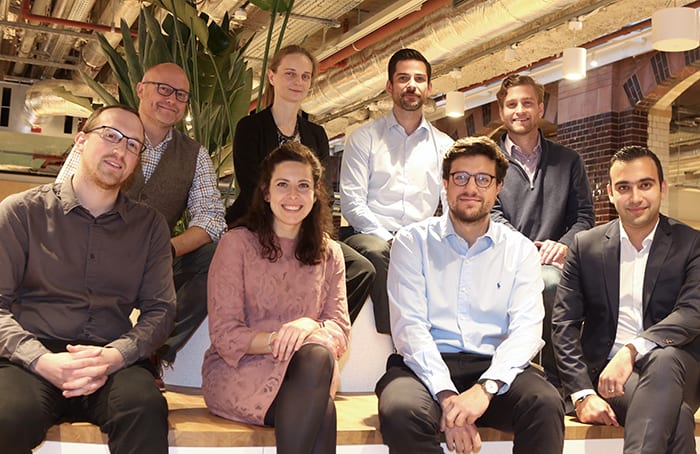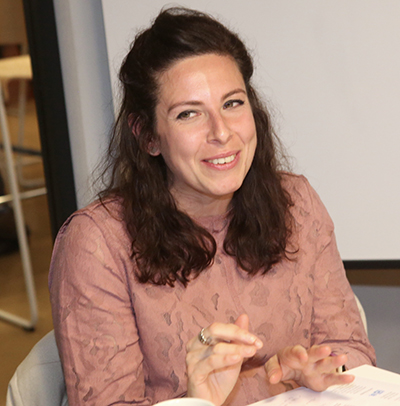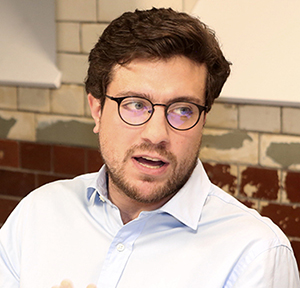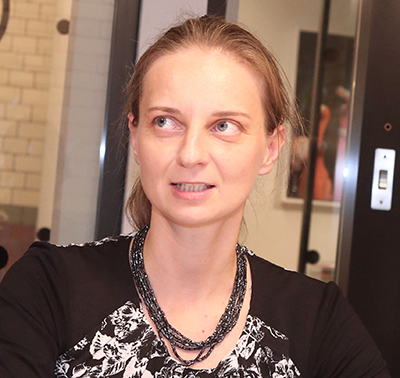Showing site teams they don’t need to be afraid of new technology is key to bringing on board the die-hard traditionalists. A CM round table, chaired by Denise Chevin and supported by Bluebeam, considered how to boost digital engagement throughout the supply chain. Photos: Christopher Woods.
Denise Chevin: If you are starting out on a digitalisation journey, are there some quick wins?
Andrew Gamblen: From the main contractors’ point of view getting naming convention, a common data environment and workflows nailed as a starter means you will generally be ok. But it is difficult and it is a different answer depending on where you sit in the supply chain.
Martin Coyne: A lot of it comes down to bringing the right solution for the right problem. You might see the best bit of technology that absolutely wows you but you need to understand the workflow and the process. There has only ever been a couple of tools in our office, Bluebeam being one of them, that just fit into our workflow. The first step is talking to the user, understanding the problem and saying: “Try this solution and then we can see where we take it from there.”
Donatella Fiorella: I think the easy win would be easy application. For example, we have some smartphones for the supply chain. If they have to give us some specifications, instead of giving us a normal Word or PDF document, they put it in this smartphone app which we import into our authorising tool. They don’t really know they are doing anything related to BIM or 3D. It is easy for them and it makes our lives so much easier.
DC: Who should drive digital innovation?
Shervin Yousefzadeh: Throughout my working experience, I have seen different approaches to the implementation of technology, top-down and teams sourcing their own solutions. Driven from the top-down, there is more direction, more support and more ambition. Clear direction is vital to the success of digital technology, one vision that guides people. I have found that that can be missing when people are sourcing their own solutions.
Urszula Kanturska: Someone needs to own and drive it. It won’t happen on its own. What worked for us was to have a dedicated team with application developers, people who do integration, business intelligence, all embedded in a construction team. What we found was that the greatest value to unlock lies at interfaces. Improving interface between a contractor and a designer, for example, is where the value lies.

Round table participants

Back row (l-r): James Chambers, regional director UKI, Bluebeam; Urszula Kanturska, construction data and technology integration lead, Bylor JV – Hinkley Point C; Andrew Gamblen, digital manager, Willmott Dixon; Joe Williams, VP of global industry insights, Bluebeam
Front row (l-r): Martin Coyne, BIM practice manager, KPF; Donatella Fiorella, BIM manager, ISG; Davide Gatti, BIM manager, Multiplex; Shervin Yousefzadeh, digital construction manager – civils, Graham Group

AG: The drive of digital technology has got to come from multiple different places at once. For it to be beneficial you need that top-down to help push it further but you also need the help from the guys on site to push it upwards. Those in the middle are generally the ones who are the most resistant.
DC: Is that the biggest challenge with digitalisation – the move from offices to take-up on site, or is it a lack of integration?
DF: Integration is a big problem. We have different issues, objectives and targets so we use different tools and they are changing all the time. Interfaces are not studied very well. The difficult part for us is to figure out the best workflow where everyone can collaborate the best without losing information. At each stage we are using different software. Exchange of information is always very difficult.
UK: I know that my end users want the tool to do no more and no less than what they need it to and the key to all these bespoke tools is common data structures. So, integration and bespoke apps is where I see it going, and I am not sure if the big software companies see it going in the same way.

Donatella Fiorella, ISG: “It is just about shifting ourselves towards another approach”
Joe Williams: I think integration becomes even more important on the mobile side of things. When we are sitting at our desktops, we have got these robust tools, we can change file formats, export import, move things around. On your mobile phone it is hard to change a file type and then load it into the software. The data has to be accessible everywhere all the time for it to really work.
SY: Interoperability is better than it used to be in 2016. It is not perfect but we’re heading in the right direction.
DC: How you measure the return on investment (ROI)? Can you measure it?
JW: This was something we always struggled with. Waiting for the ‘R’ of the ROI is always difficult. When I was in the construction industry, what we looked for instead were mistakes we could have prevented. For example, on one project a surveying team had to hand-key in some co-ordinates and transposed a few numbers and a pier was poured into the wrong place. It was a $15,000 mistake.
That single mistake could have been corrected with having the digital information and feeding it directly into the surveying device. It justified paying for a new survey instrument that could accept that type of data.
UK: I think it has been really similar for Hinkley. Years before it even got the financial sign-off, the idea was that the design from the previous power station would be taken and brought to Hinkley and built from that.
The Bylor JV have been influencing the client to try to demonstrate that there is a value in modelling everything in 3D. They have built a part of the structure – one they knew was problematic on the previous power station – and they have demonstrated the number of non-conformance reports and field change requests and requests for information. It was a dramatic drop – 70% avoided instantly – and that was something which convinced the client. For us the benefits will also not necessarily be realised on Hinkley. It is only on the next job.
James Chambers: Sometimes you don’t know what the ‘R’ is in ROI. The R can be something to each individual. It could be zero health and safety issues, it could be profitability, it could be building efficiencies which you are not going to see until two or three years of operation. By having a better definition of what the ‘R’ is, you are opening yourself up to more data to come in and say actually, we are winning here, here and here.

Davide Gatti: “I had to approach it slowly”
DC: Is virtual reality (VR) just a nice-to-have at the moment?
MC: Everyone is doing some sort of augmented reality (AR) or VR. But it comes down to how we implement it. One of the things we have seen with VR is that if you are in a meeting, a lot of people don’t like to put on a headset. You could spend hours and thousands of pounds developing this brilliant 3D model and then everyone just looks at the headset and says “Oh, that’s nice”.
DF: We have been working on these things and are trying to build up statistics to show that the clients of BIM Level 2 projects are more satisfied than clients of other projects and this is because of engagement related to the visualisation – they know what they are getting and they feel like we are listening to them.
AG: It is nice having data in the background to back up what we see. We all know that it does create efficiency. Basically, it de-risks the project. Our third or fourth-generation BIM Level 2 projects are coming up for completion in the next six to nine months and those are ones where we have really tried to push things properly. The data is looking promising and we utilise VR on a number of jobs now. There is no two ways about it – it is totally worth it.
DC: How do organisations keep innovating and how do we stop digital fatigue?
SY: I believe software vendors should understand the construction process better. They should go to the site, sit with the people who are using this technology every day and understand the process.
DF: This is just about culture change. It is not really about fatigue. Construction is very traditional and they don’t want to change, but if you think about it, it is just about shifting ourselves towards another approach.
AG: Software organisations need to understand the processes and not oversell what their technology can do. Everything has AI these days and blockchain and digital twins. That causes fatigue, because people get sold a pup.
MC: I think we are missing the opportunity to really collaborate. Yes, there always have to be differentiators but there is so much there where you can say it makes so much sense
to get around the table and do these bits together.
JC: I think we are in an exciting time. The idea of the solutions providers working with industry is critical and has to happen, and both parties have got to be very vocal with each other.
How do we demonstrate the value of digital technology to project teams that rely on traditional methods?
Shervin Yousefzadeh: “We need to show site teams they are supported and that they don’t need to be afraid of the technology. On one project I worked on, people started to understand the benefit because they could complete tasks more efficiently. After two weeks we calculated that each person had saved about half a day per week.”
Urszula Kanturska: “It is important to show someone impacted by change how introducing something new might make a massive impact on someone else. I tend not to talk to people about technology but about operational processes and efficiencies and productivity. The final thing for us is because the scale of the job [Hinkley Point C] is so big, we just went and scared everyone. The narrative was: ‘Look at the risk of not doing this. Can you afford that risk?’”
Martin Coyne: “The value that we see is twofold. There is the value of time and using processes like BIM to make sure things are co-ordinated from the start. The other real value is being able to explore the quality of the design to allow people to understand and refine the buildings we are designing.”

Urszula Kanturska: “I tend not to talk to people about technology but about operational processes and efficiencies and productivity”
James Chambers: “Values can be interpreted in so many ways – whether it is more work life balance, better quality of product, saving money on the bottom line. But if you are saving any of those things it is all value. There are some great examples where people have run very similarly scoped projects back to back, applying a digital attitude and not, and the values speak for themselves.”
Donatella Fiorella: “The first question I want to ask here is: “Value for who?” If we are talking about the senior management, they will talk about cost. In this case I would say the answer would be business cases and previous experience. They need to understand why they are doing this, so the value is related to the awareness of the tools – because many times they don’t know that the tools exist.”
Andrew Gamblen: “Everyone’s values are different. For example, some of our directors want to see more operational efficiency; some people want to see more financial stability in terms of fewer errors on site. Demonstrating value is one of the hardest things, but once you have found it for the individual who is the most anti-technology, that is when you have got the biggest uptake because that person becomes the most vocal to their peers.”
Davide Gatti: “When I came to London, I worked with a very skilled interior designer who always worked on paper. I arrived – this geeky young person – saying I am going to use technology to revolutionise the way he worked and he said ‘No way’. I had to approach it slowly. By the end, this was the person who went to the whole office to spread the word.”
Joe Williams: “You need to show people you are not there to put another burden on them but instead to help them in doing their work more efficiently. Finding quick wins to celebrate as a team makes a big difference. When one project team hears another project team is doing something cool there is a little bit of competition and wanting to do a little bit better.”















